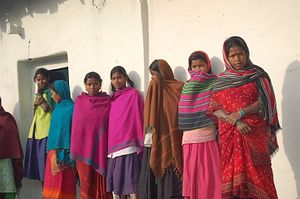The Indian state of Chhatisgarh has for long been a center of Naxal and state violence. For decades now, the state government has been involved in a brutal tussle with Maoist groups, with armed violence ensuing from both ends. Civilians in increasingly militarized villages and districts fall prey to the anger of both sides when one mistakenly assumes them to be a member of the other. As a result districts like Bastar, Bijapur, Sukma, and others, are constantly under threat.
On June 13, Madkam Hidme, a woman from the Gompad village of the Sukma district in Chhatisgarh, who belonged to the Adivasi (tribal) community was found dead with multiple injuries, allegedly in a Naxal uniform. The police announced that she was a member of Naxal Platoon 8, killed in a police encounter and found with a gun next to her as well. This story, however, stood on flimsy ground as pictures right after the encounter depict her in oversized and bunched-up pants, a clean and ironed uniform, with no telling bullet holes or other indication of participation in an encounter with authorities. An investigation by Scroll.in that pieced together an account from the family and neighbors paints a harrowing story instead.
Hidme was allegedly dragged out of her home by men dressed in police uniforms and beaten up when she resisted. Her mother was apparently hit until she was unconscious and neighborhood women who intervened, begging and pleading, were threatened and pushed away. Hidme’s body was brought back under plastic, hours later, and reportedly showed signs of a brutal rape.
Activist Soni Sori, who has been particularly vocal about such instances of violence against women in Sukma and Bijapur, went on a hunger strike after being denied the ability to visit the village or meet with the family. A demonstration was also staged outside the Chhatisgarh Tourism Board office in Kolkata, with the activists demanding justice. The mother, Madkam Lakshmi, was distraught and filed a petition with the Chhatisgarh High Court, requesting an inquiry into foul play. The court finally ordered the exhumation of the body, which was supposedly buried with salt and sand to hide evidence of the torture inflicted.
Madkam Lakshmi’s account seems to suggest that the men who dragged her daughter away both knew her and knew that she was not involved with Maoist groups. Rather, she says, they were men who used to work with the Maoists and reports being shocked to find them in police uniforms. This however seems to be a common strategy employed by the state – enticing Maoists and surrendered Maoists to join the police forces and provide intelligence.
For years, this took on a terrifying shape when the state supported the vigilante group Salwa Judum, which drew local men into the ranks of Special Police Officers (SPOs). The SPOs directly took on Maoist groups and violence escalated to a near civil war situation. In 2011, the Supreme Court declared this to be unconstitutional and called for the disbanding of Salwa Judum. It also ordered immediate compensation to victims from both sides. However, this compensation was not forthcoming and the group was in fact reconstituted in different ways. Currently, men like those Madkam Lakshmi describes form parts of the District Reserve Groups of the state and are eager to turn on not just known members of Maoist groups, but also former and retired members who are no longer involved in any threatening activities.
This deteriorating situation has been observed not just in these areas, but also the state capital of Raipur, as noted by the Congress Party, which staged a walkout from the Monsoon Assembly session of Chhatisgarh after being provided unsatisfactory answers on the issue. While members of different parties engage in angry debates over whose regime allowed violence to escalate the most, the Ministry of Home Affairs agreed to the creation of a tribal battalion to counter Maoists in the Bastar area, which is among the most militarized zones in the country.
Known as the Bastariya Battalion, this will comprise solely of members of scheduled tribes from the region and will be a wing of the Central Reserve Police Force (CRPF). In order for recruitment to be made a little easier and truly have local representation, requirements like height and weight have been relaxed a little. The idea behind it is to increase the efficiency of counter insurgency forces by tapping into local knowledge on terrain. The initiative will also make joining the Maoists a less tempting option for local unemployed youth.
It is important to remember, however, that violence in Chhatisgarh is not just from the end of the Naxal insurgency, but from state police forces as well. This is particularly important given that, in the past, neither side has been remotely lenient to people they suspect of belonging to the other. Ultimately, these forces need to be trained and deployed with care.
































